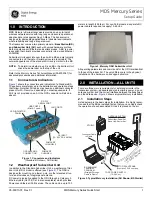
5.15 Welding procedure for sanitary and Pulp&Paper
spuds
1. Using appropriate size hole saw, cut a hole in the process
vessel to accept the spud. The hole should couple with
the spud perfectly.
2. Remove the weld spud from the transmitter and secondly
the PTFE gasket from the weld spud (if any).
3. Position the weld spud in the vessel hole and start
welding. For this important phase, please look at and
follow the welding sequence (see figure below).
4. Cool each section properly before proceeding to the next
section.
5. Use between 100 and 150 amps. and adjust the
amperage, if needed, for spud penetration.
6. After the weld spud has cooled, install the PTFE gasket
into the weld spud. Ensure the gasket is properly
positioned within the weld spud; improper placement can
cause a process leak.
7. Position the transmitter into the spud and engage the
threads. Rotate the transmitter and thread it completely.
8. Tighten the transmitter or, if in case of pulp and paper
cylindrical spud, install the needed bolt(s).
Figure 47: Welding sequence for spuds
IMPORTANT.
Users should install spuds carefully.
Please follow the notes below:
—
Position inside gasket (if any) perfectly in order to avoid
process leaks.
—
Improper installation may result in spud distortion.
—
Excessive heat will distort the spud.
—
Allow adequate cooling between welding and the
following operations.
—
Weld the spud properly on tank or vessel walls in order
to avoid personal injury or plant damage.
5.16 Sanitary spuds (3-A recommendations)
Use of proper procedures and fixtures permits the flanges to be
welded to the maximum wall thickness.
The recommended minimum radius of curvature of the tank is
0.91 m (3 feet).
The spud has to be welded so that the welding surface remains
smooth and without irregularities where dirt can lodge. The
spud leak detection hole has to be positioned at the bottom of
the spud.
For sanitary spud welding procedure, please refer to the
following figure.
Figure 48: Sanitary spud and welding point
2600T Series Pressure transmitters |
OI/S266-EN Rev. B 37




































